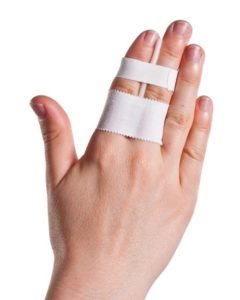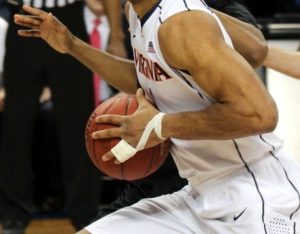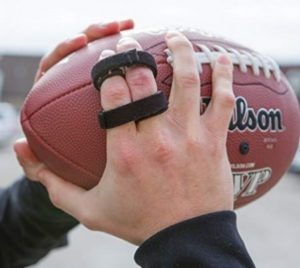Buddy taping is the practice of bandaging an injured finger together with an adjacent healthy one for support. Serving as a type of splint, the healthy finger is wrapped closely to the sprained, dislocated or fractured finger allowing both movement and a natural position conducive to injury protection.
Buddy taping is used frequently in sports where finger injuries are common, such as volleyball, football and basketball. It can serve as a temporary solution to help an athlete through a game or provide the necessary support facilitating recovery of a minor injury. In some cases, it is also used to help prevent injuries.
As a “quick fix” post injury, buddy taping provides protection to the injured finger and keeps it out of the way so that an athlete can maintain grip and level of performance without causing further injury.
As an injury prevention measure, buddy taping may reduce risk of injury by preventing the fingers from moving past their normal range of motion during a fall or other impact [1].
Additionally, some athletes report increased grip strength when taped and practice buddy taping to provide additional grip strength as well as grip traction, in lieu of gloves, to improve performance. Though, these perceived benefits have not been scientifically proven.
How Buddy Taping is Performed
Buddy taping is a simple process that can be performed easily with just a few items. A piece of thin foam or padding the length of the finger is generally placed between the two fingers, a relatively stiff tape from ½ to 1 inch in thickness is placed around the fingers, leaving the joints uncovered to facilitate bending. This may be applied directly to the fingers or over gloves (football). Depending on the thickness of the tape, one or two layers may be applied. In some cases, a buddy tape “splint wrap” also known as “buddy loops,” a breathable foam line with a non-slip hex material that grips the skin, may be used.
Buddy taping is intended to provide “temporary” support. While it may remain on several days following an injury, all finger injuries should be assessed by a hand specialist.
Concerns about Buddy Taping
While taping digits together have become common practice, particularly in sports, some research suggests a potential for complications warranting concern and caution among those performing buddy taping to treat finger and toe injuries.
The authors of a recent study reported frequently seen complications such as necrosis of the skin, infections, loss of fixation and limited joint motion.
According to the surgeons included in the study, some of the indications for buddy taping included finger fractures, metacarpal fractures, metacarpophalangeal (MCP) joint injury, proximal interphalangeal (PIP) joint injury and carpometacarpal joint injury of the hand.
While benefit was recognized, concerns remain in low patient compliance and skin injury in the treatment of both finger and toe injuries [2].
References
- Jack Gerard. Why do football players put tape around their fingers? https://healthyliving.azcentral.com/football-players-put-tape-around-fingers-1057.html
- Sung Hun Won MD, Sanglim Lee MD, Chin Youb Chung MD et al. Buddy Taping: Is it a Safe Method for Treatment of Finger and Toe Injuries? Clin Orthop Surg. 2014 Mar;6(1):26-31. doi: 4055/cios.2014.6.1.26





Comments are closed.